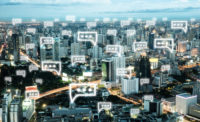The COVID-19 pandemic has caused a tremendous degree of devastation, both economically and emotionally. To say that it's been trying would be putting it lightly—for many businesses, it represents the greatest challenge they've ever faced. Given the amount of attention it's received, one might say it's viral in more ways than one.
A bit of levity is important these days. And with that said, there's a silver lining here. As is often the case with disruption on the level created by the coronavirus, we've seen positive ripple effects in multiple industries.
Technological innovations representing new, advanced solutions to a previously unforeseen problem. Advancements that, even once the pandemic is finally dealt with, will continue to change not only their respective industries but also the world. The fields in which such innovation is most prevalent are, not surprisingly, healthcare and the public sector.
Here are just a few ways in which this has manifested.
Transparency, Information, Communication
It's no secret that this pandemic created widespread panic and chaos. Uncertain of what the future held, countless individuals engaged in panic buying, supply hoarding, and price gouging. Worse still, misinformation still runs rampant, creating waves of anti-mask sentiment which only serves to worsen an already dire situation.
Alleviating this panic is imperative, and it's an area in which technology plays a pivotal role. New smartphone applications, for instance, equip people with access to current health and safety information, limiting the pandemic's spread through more effective contact tracing measures. Many of these applications also provide online, at-home medical advice, and guided self-checks.
Companies like Google, TikTok, Facebook, and Twitter have an even more important part to play. Given that they are where much of the world turns to receive news, they must allocate both time and resources to damming the flood of misinformation. They must work tirelessly to direct people away from incorrect sources and articles, ensuring that people are presented with reputable, accurate information.
Apple took this one step further with the screening app Apple COVID-19.
Developed with help from the CDC and the Federal Emergency Management Agency (FEMA), the app contains up-to-date, relevant information pulled exclusively from reliable sources. These include proper handwashing techniques, quarantine advisories, social distancing FAQs, and self-assessment tools. It also offers guidance on what to do if potentially exposed, when returning from another country, or if you're experiencing symptoms.
Artificial Intelligence Learns About COVID
Machine learning represents another critical resource in tracking and preventing the pandemic's spread. As explained by The Stanford Institute for Human-Centered Artificial Intelligence, the proper application of AI alongside location monitoring and natural language processing can be crucial in identifying, containing, and predicting outbreaks based on collected data. By training analytics platforms to recognize not only the signs of an impending wave but also potential symptoms of COVID, protective measures can be implemented with a surprising degree of accuracy.
A piece published by healthcare journal Nature Medicine, for instance, examined algorithms present in a COVID-19 app that allowed self-reporting of symptoms. Not only were these algorithms able to predict infections with a surprising degree of accuracy, but they also identified a previously-unknown symptom of the virus, specifically the loss of taste and smell. These apps can also help maintain medical supply chains, alleviate pressure on healthcare professionals, and enforce restrictions.
In March, Microsoft collaborated with the U.S. Centers for Disease Control and Prevention (CDC) to create an AI-powered COVID-19 assessment bot. The bot, nicknamed Clara, is based in Microsoft Azure. It can evaluate a person's reported symptoms, advise on next steps, and track users most in need of urgent care.
The spread of the novel coronavirus has driven the scientific community into a frenzy. We've seen a near-staggering degree of collaboration and cooperation between stakeholders as diverse as pharmaceutical companies, biotechnology organizations, and even nanotechnology firms. For instance, as reported by Biopharma publication Fierce Biotech, one team of Stanford researchers is exploring gene editing as a possible treatment, with a great deal of success.
Where does AI play into this, though?
First, as noted by Nature, it's capable of scanning and analyzing a massive volume of research data, from the results of clinical trials to published research and literature. Armed with this data, it can provide a range of insights. These include suggesting new treatments, providing potential vaccine components, and examining how the virus may develop and evolve.
Second, as demonstrated by the National Institute of Health, it can help provide more accurate, faster diagnoses based on medical records such as x-rays, particularly of the chest and lungs. This has not only helped improve COVID-focused imaging technology but is also leading to the creation of new diagnostic and treatment techniques.
The Human Side of Technology vs. COVID
Technology is often presented in popular culture as ruthless, unfeeling, and mechanical. While this may not be entirely false, the range of ways in which it can assist in the COVID-19 pandemic are nearly endless, and often entirely unexpected. For instance, one might not expect smart home technology to have many applications where the pandemic is concerned.
Thing is, it can be operated remotely, often through a smartphone app. This means that instead of touching common transmission vectors such as light switches and door handles, we can rely on sensors and smartphone apps. It's a potential innovation that goes well beyond automatic doors and hand sanitizer dispensers.
What's more, videoconferencing applications are invaluable in addressing some of the more challenging aspects of quarantine and social distancing. They can help charitable organizations coordinate community responses, improve the capacity to work from home, and even provide live chat with therapists for people feeling overwhelmed by the pandemic. Outside the workplace, they offer people a means to connect with friends and loved ones for everything from online board games to digital movie nights.
Along that same vein is telemedicine. Already gaining in popularity worldwide prior to the pandemic, COVID-19 represented a perfect storm for the field's explosive growth. Offering services such as remote patient monitoring and interactive medical appointments, it proved itself a great asset in not only keeping our most vulnerable safe but also reducing exposure for frontline healthcare workers.
Alongside telemedicine, instant-read thermometer devices are being used worldwide, allowing for accurate temperature measurement with a much lower risk of exposure. As these devices function automatically, they can be mounted near entry points, improving the screening process for facilities such as hospitals, schools, and workplaces. By logging and tracking this thermometer data, we can also more effectively identify potential outbreaks and pre-emptively direct resources towards those areas.
The use of high-performance infrared thermal cameras to capture people's temperatures in real-time has also proven effective, with feeds being gathered alongside diagnostic to optimize each region's local response plan and knowledge-base.
And once the pandemic ends, the potential applications of these tools are boundless, from allowing better collaboration between healthcare professionals to providing care to remote regions.
Creativity and Collaboration in a Time of Crisis
Companies from large tech firms to local breweries are consistently brainstorming new ways to help both their workforce and their larger community as the pandemic stretches on. Contactless transactions, virtual meetings, and digital workflows are only the beginning. Local restaurants and breweries are providing their own self-produced hand sanitizer to alleviate supply shortages, while small businesses now offer everything from live-streamed online courses to curbside pickup of groceries.
Perhaps the largest contribution we've seen, however, is in the manufacturing sector. Large machinery manufacturers, for instance, are turning their factory floors to the creation of ventilators, extra hospital beds, and even pop-up hospitals. Perhaps inspired by this example, we're also seeing a surge in home 3D printing.
Savvy educators have long been encouraging youth to explore new technologies, chief among them 3D printing and software development. And that's paid off. 3D printing has emerged as a rising star during this challenging time.
And it's allowed communities to band together in some incredible ways. Per business publication Fast Company, for instance, a 12-year-old Canadian recently created an ear guard designed to reduce chafing from the elastic bands on surgical masks. And countless hobbyists have moved from printing miniatures and models for face masks, ventilators, and other vital PPE, leveraging the open-source nature of the 3D printing field to great effect.
Working together, they're helping to ensure that medical supplies are being produced fast enough to keep up with global demand.
Finally, we're also seeing countless other ideas, such as the use of drones and autonomous vehicles for safer deliveries in the event of a full lockdown.
Closing Thoughts: The Road Forward
Pharmaceutical companies and other research agencies are working diligently and tirelessly towards a cure. Although the true effects and extent of the novel coronavirus are yet unknown, the medical and scientific community are making excellent headway, collaborating with one another on a global stage. Technology such as AI, telemedicine, and smart hardware is invaluable in these efforts.
In the race to contain the spread of COVID-19 and seek a cure, governments, and corporations all over the world have deployed and integrated new technology into their pandemic response plans. This has created an atmosphere of constant innovation and demand. And while new software and hardware cannot entirely replace effective policies and processes, it's nevertheless an invaluable addition.
Cybersecurity technology is one aspect of the fight I've not yet mentioned. Don't think that means it's unimportant, though. Secure access to sensitive data is absolutely imperative, especially now, as more people work from home and criminals are targeting healthcare data with increasing frequency.
Ultimately, the fight against COVID-19 isn't a race. It's a marathon. And as it continues, we must all work together, using every tool at our disposal to keep people as safe and healthy as possible while we work towards a cure.
And once that cure has finally been deployed, there is no doubt in my mind that we'll see the technology we developed put to use elsewhere—to build a better, brighter future for everyone.
This article originally ran in Security, a twice-monthly security-focused eNewsletter for security end users, brought to you by Security Magazine. Subscribe here.



